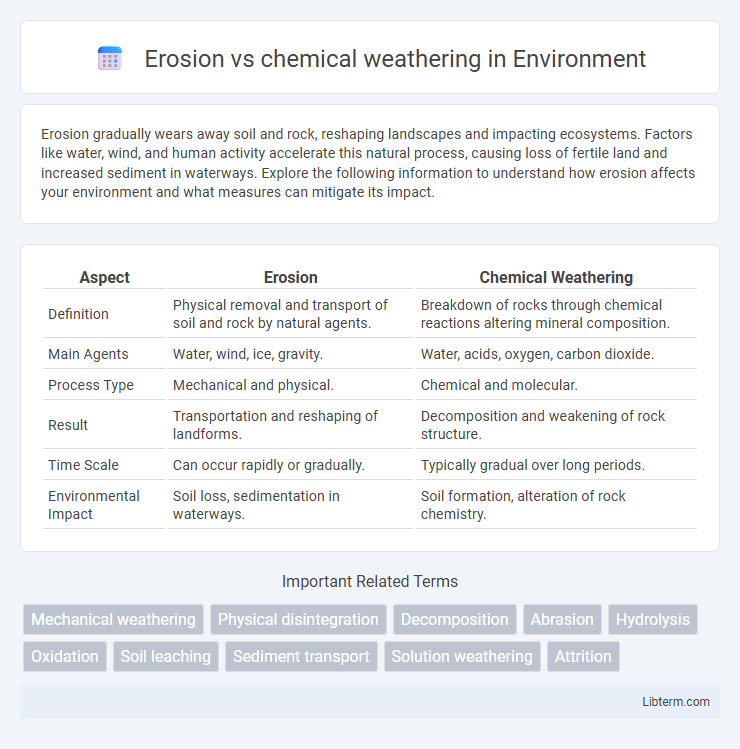Erosion gradually wears away soil and rock, reshaping landscapes and impacting ecosystems. Factors like water, wind, and human activity accelerate this natural process, causing loss of fertile land and increased sediment in waterways. Explore the following information to understand how erosion affects your environment and what measures can mitigate its impact.
Table of Comparison
| Aspect | Erosion | Chemical Weathering |
|---|---|---|
| Definition | Physical removal and transport of soil and rock by natural agents. | Breakdown of rocks through chemical reactions altering mineral composition. |
| Main Agents | Water, wind, ice, gravity. | Water, acids, oxygen, carbon dioxide. |
| Process Type | Mechanical and physical. | Chemical and molecular. |
| Result | Transportation and reshaping of landforms. | Decomposition and weakening of rock structure. |
| Time Scale | Can occur rapidly or gradually. | Typically gradual over long periods. |
| Environmental Impact | Soil loss, sedimentation in waterways. | Soil formation, alteration of rock chemistry. |
Introduction to Erosion and Chemical Weathering
Erosion involves the physical removal and transportation of soil, rock, or sediment by natural agents such as water, wind, or ice, reshaping landscapes over time. Chemical weathering refers to the chemical breakdown of minerals within rocks through reactions with water, oxygen, acids, or biological activity, leading to material alteration at the molecular level. Both processes contribute to landscape evolution but differ fundamentally in mechanism: erosion is a physical displacement, while chemical weathering transforms rock composition.
Defining Erosion: Processes and Agents
Erosion involves the physical removal and transportation of soil, rock, or sediment by natural agents such as water, wind, ice, and gravity. Processes of erosion include hydraulic action, abrasion, and deflation, which collectively reshape landscapes by wearing down surfaces and redistributing materials. Unlike chemical weathering, erosion does not alter the chemical composition but modifies the Earth's surface through mechanical means.
Understanding Chemical Weathering: Mechanisms and Effects
Chemical weathering involves the breakdown of rocks through chemical reactions such as hydrolysis, oxidation, and carbonation, altering the mineral composition and structure of the material. This process leads to the formation of clay minerals, soluble salts, and secondary minerals that weaken rock integrity. Unlike erosion, which physically transports weathered material, chemical weathering transforms rock in situ, significantly influencing soil formation and landscape development.
Key Differences Between Erosion and Chemical Weathering
Erosion involves the physical removal and transportation of rock or soil by agents like water, wind, or ice, whereas chemical weathering refers to the chemical breakdown and alteration of minerals within rocks through processes such as oxidation, hydrolysis, and carbonation. Erosion reshapes landscapes by moving materials to new locations, while chemical weathering changes the mineral composition and weakens rocks in situ, often leading to soil formation. The key difference lies in erosion being a mechanical process driven by external forces, whereas chemical weathering is a chemical process altering the rock's internal structure.
Types of Erosion: Water, Wind, Ice, and Gravity
Water erosion shapes landscapes through rivers, rainfall, and ocean waves, transporting sediments and carving valleys. Wind erosion moves fine particles across arid regions, forming dunes and deflating surfaces. Ice erosion occurs via glaciers grinding rock beneath them, while gravity-driven erosion causes landslides and rockfalls, moving materials downslope rapidly.
Major Forms of Chemical Weathering: Hydrolysis, Oxidation, and Carbonation
Erosion involves the physical removal and transport of soil and rock by wind, water, or ice, whereas chemical weathering alters the mineral composition of rocks through chemical reactions. Major forms of chemical weathering include hydrolysis, which breaks down silicate minerals by reacting with water; oxidation, where oxygen reacts with minerals containing iron, forming rust-like oxides; and carbonation, involving carbon dioxide dissolving in water to form weak carbonic acid that dissolves carbonate rocks. These processes significantly contribute to soil formation and landscape changes by weakening rock structures at a molecular level.
Environmental Factors Influencing Erosion and Chemical Weathering
Environmental factors influencing erosion include precipitation intensity, vegetation cover, and topography, which together determine soil stability and sediment transport rates. Chemical weathering is primarily affected by temperature, moisture availability, and the presence of acidic conditions that accelerate mineral breakdown. Both processes interact dynamically, as increased erosion can expose fresh rock surfaces to chemical weathering agents, while climate and biological activity modulate their relative impacts on landscape evolution.
Real-World Examples of Erosion vs Chemical Weathering
Grand Canyon exemplifies erosion through the Colorado River carving deep valleys over millions of years, while chemical weathering occurs in the same region as rainwater reacts with limestone, dissolving rock and creating caves. Coastal cliffs at Dover demonstrate erosion as waves physically break down chalk formations, contrasted by chemical weathering in karst landscapes where acidic rainwater alters limestone. Urban pollution accelerates chemical weathering by producing acid rain that deteriorates marble statues, whereas glaciers exemplify erosion by physically transporting sediment through ice movement.
Impacts on Landscapes and Ecosystems
Erosion reshapes landscapes by physically removing soil and rock, leading to altered landforms such as valleys, cliffs, and deltas, which can disrupt habitats and nutrient cycles in ecosystems. Chemical weathering breaks down minerals through chemical reactions, changing soil composition and rock structure, influencing vegetation growth and water chemistry. Both processes significantly impact ecosystem stability and biodiversity by modifying habitat availability and resource distribution.
Human Activities and Their Role in Erosion and Chemical Weathering
Human activities such as deforestation, mining, and urban development accelerate erosion by removing vegetation cover and disturbing soil structure, leading to increased sediment transport and landscape degradation. The use of acid rain-inducing pollutants like sulfur dioxide and nitrogen oxides from industrial emissions enhances chemical weathering by altering the pH balance of rainwater, which intensifies the breakdown of minerals in rocks. Agricultural practices involving excessive irrigation and the application of fertilizers also contribute to both erosion and chemical weathering by altering soil chemistry and increasing runoff.
Erosion Infographic

 libterm.com
libterm.com